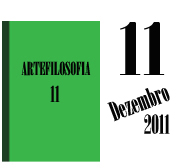Guerra aérea, modernismo y artes visuales:
Contra el Guernica
Abstract
Contemporary war and the aesthetic tensions of Modernism have some common traits that might illuminate each other’s reality. This article tries to point out some of those characteristics by analyzing a concrete case, Picasso’s Guernica, considered one of the most important examples ofpolitical art of the XXth. Century. A political analysis of air bombing based on the theories of Carl Schmitt is combined here with the consideration the Modern work of art as being situated in a fieldof forces, as Adorno stated in his Aesthetic Theory. This combination of perspectives allows a better clarification of Guernica’s difficult reception along the time. This article pays particular attention toan odd writing by the Spanish artist Antonio Saura, where he recorded his reactions when Guernica arrived in Madrid. The old relationship between war an art could be thought again considering theradical transformations of technology and the revolutions of the artistic avant-garde.
Downloads
References
ADORNO, Theodor. Teoría estética, Obra completa 7, Madrid, Akal, 2004, trad. J. Navarro Pérez, p. 337; Theodor W. Adorno, Ästhetische Theorie, Gesammelte Schriften 7, Frankfurt a. M., Suhrkamp, 1997, pp. 379-380.
DE LA PUENTE, Joaquín. El Guernica. Historia de un cuadro, s/l, Silex, 1987; Jean-Louis Ferrier, De Picasso a Guernica. Généalogie d’un tableau, Paris, Hachette, 1998.
EUGENIO F. Granell, Picasso’s “Guernica”.The End of a Spanish Era, Ann Arbor: Michigan, UMI Research Press, 1981.
GALBRAITH, John Kenneth. Memorias.Una vida de nuestro tiempo, Barcelona, Grijalbo, 1982, trad J. A. Bravo, págs. 229-235, 244 y 257.
HEGEL, G.W.F. Principios de la filosofía del derecho, Buenos Aires, Sudamericana, 1975, § 328, págs. 375-376, trad. J. L. Vermal; G. W. F. Hegel, Grundlinien der Philosophie des Rechts,Suhrkamp, Frankfurt. a. M., 1993, § 328, p. 496.9
MORRIS, Errol. The Fog of War. Eleven Lessons from the Life of Robert S. McNamara (2003). La película ganó un Oscar al mejor documental. Sitio oficial: http://www.sonyclassics.com/fogofwar/[acceso: 8. 4. 2011]. La película está disponible en: http://video.google.com/videoplay?docid=-6733596013688235740&ei=V29BS7vxJJKF-QaYt-ynBg&q=movie+agent+-Charlie+-Waco+-year&view=3&dur=3# [acceso: 8. 4. 2011].
SCHMITT, Carl. El Nomos de la Tierra en el Derecho de Gentes del Jus Publicum Europaeum, Madrid, Centro de Estudios Constitucionales, 1979, trad. D. Schilling Thon, pp. 418 y ss.
SAURA, Antônio. Fijeza. Ensayos. Barcelona, Galaxia Gutenberg, 1999, págs. 148-153.
SAURA, Antônio. Contra el Guernica. Libelo. Mont-sur-Lausanne, Archives Antonio Saura (Ginebra) – Museo Nacional Centro de Arte Reina Sofía de Madrid – Ediciones de la Central (Barcelona), Prefacio de Félix de Azúa.
SEBALD, W.G. Sobre la historia natural de la destrucción, Barcelona, Anagrama, 2003, trad. M. Sáenz.
SHAPIRO, Meyer. The Unity of Picasso’s Art, Nueva York, G. Braziller, 2000, p. 169 y ss.
TRAVERSO, Enzo. A sangre y fuego. De la guerra civil europea, 1914-1945, Buenos Aires, Prometeo, 2009, trad. M. A. Petrecca, p. 118.
TRAVERSO, Enzo. A sangre y fuego , pp. 119-120.
Copyright (c) 2017 Revista ArteFilosofia

This work is licensed under a Creative Commons Attribution-NonCommercial-ShareAlike 4.0 International License.
Autores que publicam nesta revista concordam com os seguintes termos:
- Autores/as mantém os direitos autorais e concedem à revista o direito de primeira publicação, com o trabalho simultaneamente licenciado sob a creativecommons.org/licenses/by-nc-sa/4.0/ que permite o compartilhamento do trabalho, com reconhecimento da autoria e publicação inicial nesta revista.
- Autores/as têm autorização para assumir contratos adicionais separadamente, para distribuição não-exclusiva da versão do trabalho publicada nesta revista (ex.: publicar em repositório institucional ou como capítulo de livro), com reconhecimento de autoria e publicação inicial nesta revista.


